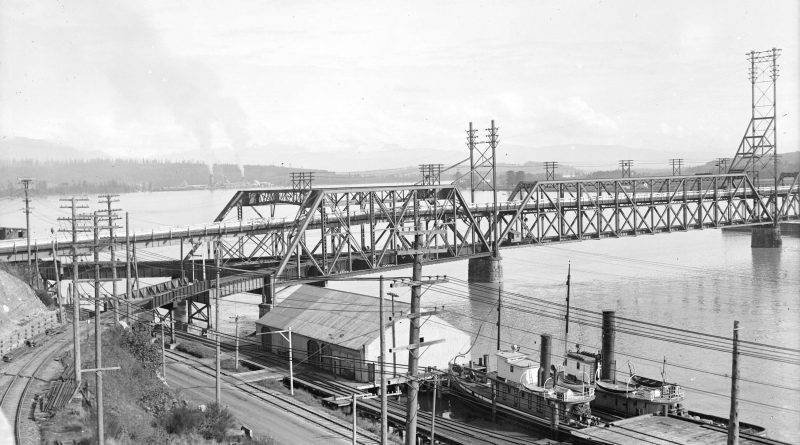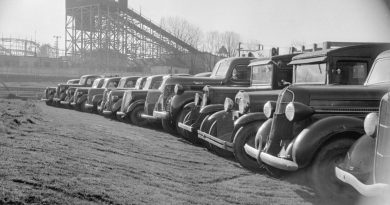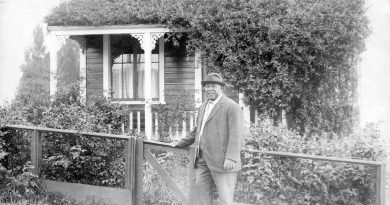1920
Above: Fraser River Bridge, New Westminster circa 192?
[Image: City of Vancouver Archives AM54-S4-: SGN 997]
*****************************************
You’ll note that these years include events listed under “Also in . . .” These are events for which we don’t have a specific date. If YOU know the specific date of an event shown there, please notify us . . . and cite the source! Many thanks!
*****************************************
January 1 The Polar Bear Club swim was started by Peter Pantages. Every New Year’s Day, for more than 80 years now, several hundred cold-defying people leap screaming in their bathing suits (or other more unorthodox attire) into the chilly waters of Vancouver’s English Bay.
January 5 The Boston Red Sox sold Babe Ruth to the New York Yankees.
January 15 Bob Smith, long-time CBC jazz show host, was born in Winnipeg. For more than 30 years—from Saturday, February 1, 1947—he was host of Vancouver’s longest-running jazz radio show Hot Air. He also wrote a long-running column on jazz for the Vancouver Sun. He was a walking encyclopedia of the music.
January 16 Prohibition started in the USA. It ended in 1933.
January A traffic count on the Fraser River bridge revealed that more than 13,000 trains—passenger, freight and mixed—crossed during the previous year (an average of more than 35 a day). By comparison, 65 automobiles per hour was the highest count for the upper span.
February 3 The Vancouver harbor police were formed.
February 4 North Vancouver mountaineers Don and Phyllis Munday married. By 11:00 a.m. they were climbing one of the local mountains. The Mundays discovered Mt. Waddington, B.C.’s highest peak, in 1923.
March 3 Wales-born David Spencer, Sr., who founded the Spencer’s Department Store chain, died at age 82 in Victoria. He bought a dry-goods store in Victoria (1873) which became David Spencer Ltd., established branches in Nanaimo (1889), Vancouver (1906) and other B.C. centres.
Also March 3 Actor James Doohan was born in Vancouver. He’s most well-known as Scotty in the original Star Trek series. He died July 20, 2005.
March 28 Labor activist Bill (William Arthur) Pritchard, 31, was arrested and found guilty of seditious conspiracy today, following an inflammatory speech in June 1919 during the Winnipeg General Strike. He was the head of the Vancouver Longshoremen’s Union, and an executive member, of the Vancouver Trades and Labor Council. He spent a year in jail. He was reeve of Burnaby from 1930 to 1932.
April 2 A striking Japanese-Canadian War Memorial, designed by Vancouver architect James Benzie, was installed at Stanley Park. It commemorates Japanese-Canadians who fought in World War I. It’s there to this day, a handsome structure surrounded by flowering cherry trees. A Japanese-Canadian entrepreneur, Koichiro Sanmiya, sold war bonds to raise the money for the memorial.
April 8 Bill (Wilfred John) Duthie, bookseller, was born in Weston, Ont.
April 18 Henry Osborne Alexander, the first white male born on Burrard Inlet (December 13, 1873 at Hastings Mill) died in Vancouver. He was called to the bar in 1896 and practiced in Vancouver, later becoming a judge. On January 10, 1908, when two South Vancouver neighbors came to court over ownership of a rooster, Magistrate Alexander ordered the bird turned loose on the street to decide for itself where it belonged.
April 22 A chapter of the I.O.D.E. (Imperial Order Daughters of the Empire) started in West Vancouver.
May 22 Ireland-born George McSpadden, Vancouver’s first building inspector and assessor, died here at age 54. In 1900 he took a census of Vancouver’s population (just over 23,000). He built his residence at Commercial Drive and Charles Street in East Vancouver. A street and a park are named for him.
May The Group of Seven painters formed in eastern Canada. One of them, Lawren Harris, came to Vancouver in 1940, aged about 55, and lived here to his death January 29, 1970. He is considered one of Canada’s greatest painters.
June 8 Wales-born CPR executive Richard Marpole died in Vancouver at age 69. He was the CPR’s manager when the first passenger trains crossed Canada and the first in North America to prepare timetables based on a 24-hour system. An exciting episode in his life: he was a member of the posse to catch the “Grey Fox,” Bill Miner, on May 14, 1906, after Miner’s second train robbery.
June China-born Chang Toy, Vancouver businessman, died in China on a business trip. He was 64. It was Chang who built the famous Sam Kee Building in Chinatown, narrowest commercial building in the world.
July 12 Author Pierre Berton was born.
July Construction began on the Peace Arch.
August 5 Fire destroyed much of downtown Port Coquitlam. It started above the firehall, in the residence of the Fire/Police Chief. Half the city’s buildings along the Dewdney Trunk Road were destroyed. No one was injured.
August 13 Garibaldi Park was officially opened. Why was a B.C. park named for an Italian patriot? According to place-name experts G.P.V. and Helen B. Akrigg, “A colorful story has it that Mount Garibaldi was named by an Italian serving as a sailor on a survey ship, the mountain being on view on Garibaldi’s birthday (July 4). All we can say with certainty is that the name, whatever its origins, was officially conferred by Captain Richards of HM survey ship Plumper sometime around 1860.” The park was later named for the mountain.
September 10 Robert Bonner, future attorney-general, was born.
October 17 The first plane to fly right across Canada arrived in Richmond from Halifax. It had taken 10 days of travel. At the controls: two Canadian Air Force pilots.
October 20 Prohibition ended in B.C., three years and 19 days after it began.
November 5 Frank Ogden, the Coal Harbour-based futurist more commonly known as Dr. Tomorrow, was born in Toronto. He travels the world talking about the future, which he sees through an unorthodox, often unfashionable, lens: “A country that isn’t fair to its rich will soon be too broke to be fair to its poor.”
November Construction on the Peace Arch, directed by W.E. Simmons of Vancouver, was stopped to allow time for the concrete to set. It resumed in June, 1921.
December 24 Walter Cameron Nichol, the editor and proprietor of The Daily Province, became Lieutenant-Governor of British Columbia. He is the only journalist so honored.
Also in 1920
Radio CJCE began. Then they went off the air, and returned in 1921 as CFCQ. Still later, 1922, they signed on as CKMO. Click here for more.
In the Colebrook area of Surrey a big tree (276 feet high) was cut down. In it the loggers found an eagle’s nest so big it was too large for a farm wagon to haul it away.
UBC surrendered two million acres of land given as an endowment by the provincial government, and took in turn 3,000 acres adjacent to the east of the university’s site—the University Endowment Lands.
Five-pin bowling (invented by Tom Ryan of Toronto) came to the Lower Mainland of B.C. By 1945 it will overtake ten-pin in the number of its followers.
A referendum brought in an experiment [in Vancouver] with proportional representation, then being tried out in a number of North American cities. Three years later, in 1923, another referendum brought back the eight-ward, single-member system.
The Architectural Institute of British Columbia (AIBC) was founded in 1914 under the Friendly Societies Act and incorporated in 1920 under the Architects Act.
Richmond’s Minoru Park, closed during World War I, re-opened as Brighouse Park, named for pioneer Samuel Brighouse, a Lulu Island farmer. (Minoru was named for a racehorse.) Brighouse had been one of the “Three Greenhorns.”
Short Street in Kitsilano (it was one block long) was renamed Greer Street, for pioneer Sam Greer. In 1952 it would be renamed again, and is now Fleming Street.
The fifth annual South Vancouver Horticultural Association and Farmers’ Institute was highlighted by a honey competition and goat show.
“Casa Mia,” a spectacular mansion on Southwest Marine Drive, was built for George Reifel, the namesake of the waterfowl sanctuary on Westham Island.
Captain John Cates sold his resort complex—including the Hotel Monaco, Terminal Hotel and the Terminal Steamship ferry fleet—on Bowen Island to the Union Steamship Company of B.C., and moved to the province*s interior. (He would return in 1924 to construct a house and run a hotel at Crescent Beach.) On summer weekends as many as 5,000 passengers board the boats to Bowen.
In North Vancouver City Fire Chief Sparks and his entire force went on strike—and were dismissed.
The Union Bank (architect: Woodruff Marbury Somervell—that’s one man) opened at Hastings and Seymour. Today, it’s a Toronto-Dominion branch.
The CNR built a low-level bridge over the North Arm of the Fraser. Friend (and train buff) Jim McGraw confirms the bridge is in daily use to this day. “Going downstream on the Fraser starting at the Fraser River Railway bridge (built in 1904), we next come to the Pattullo Bridge, then the SkyBridge (SkyTrain) We follow the North Arm of the river and the next bridge is the Queensborough, then comes the CN swing bridge you mention. Continuing further downstream, we would then come to the Knight Street bridge and so on . . . Most of the time the bridge is left open (for marine traffic) and only closed for trains. The trains are locals that access the Lafarge cement plant and other newer industry on the south side of Lulu Island via a spur line. The main portion of the line turns west on Lulu Island servicing various industries in North Richmond. The only place to see the bridge is when you drive on River Road (the one in Richmond not Delta). The road follows the southern shore of the North Arm of the Fraser and you actually drive under the bridge’s approach.”
Arrests for prostitution in Vancouver, which topped at 20 in 1900, increased to 500 this year.
Jericho Beach Air Station was established. Seaplanes from Jericho surveyed the coast and provided flight training.
The local Field Brigade, Royal Canadian Artillery, was established.
Belgium became the third country to appoint a consul to Vancouver. (The first two were Chile in 1892 and Brazil in 1915.)
Hadassah was established in Vancouver. The national organization has an excellent web site — click here to view.
The Children’s Protective Association initiated the removal of Chinese students from the classroom.
A little two-room schoolhouse called Strathcona Heights was built on a rocky slope at 5300 Maple Street. On that property today: Quilchena Elementary.
John Wesley Sexsmith died, aged 90. He had been a successful farmer in Richmond, founded the first school in that area and spearheaded the building of the first bridge connecting Lulu Island to the mainland and Vancouver. A Vancouver school is named for him.
The Anglican Theological College was formed, an amalgamation of Latimer Hall and St. Mark’s Hall.
A group of artists, educators, and art patrons formed the British Columbia Art League to lobby the provincial and city governments for a school. The Vancouver School of Decorative and Applied Arts would open its doors in 1925. Today, it’s called the Emily Carr Institute of Art & Design.
The Gyro Club was established. There are seven branches in the lower mainland.
Yellow Taxi began doing business here with a single car owned by Roy Long, a lawyer.
The Canadian Air Board was created to govern aviation in Canada.
The first B.C. Federation of Labour was disbanded when workers across western Canada joined the One Big Union, organized to represent everyone. The OBU had a short life.
Artist Charles Edenshaw died. See samples of his work here.
The same year Edenshaw died, equally famed native artist Bill Reid was born.
David Lambie “Davey” Black became club pro at Shaughnessy Golf Club. He would hold that job for 25 years.
Motorcycle dealer Trev Deeley was born.
Bill (Wilfred John) Duthie, bookseller, was born in Weston, Ont.
Yvonne Millicent Firkins, theatre producer and director, born in Worcester, England, came to Vancouver. She will become a powerful figure in local theatre. She opened the Arts Club Theatre in 1964.
Liverpool-born Gerald Rushton, 22, arrived in Vancouver and began working for the Union Steamship company. He was with them for 38 years, became an expert on the coast’s maritime history. He wrote Whistle up the Inlet and Echoes of the Whistle.
Nova Scotia-born Garnett Gladwin Sedgewick, 36, became head of the English Department at UBC. The university’s Sedgewick Library is named for him.
By 1920 Horseshoe Bay had become a summer destination for many campers, picnickers and weekend fishermen, who traveled by train for a 50-cent fare on a regular 30-minute service. Summer cabins—often wood frames covered with canvas—are built during the summer and rented out.
In the 1920s the Blue Funnel Jitney Service charged 50 cents for a trip from Port Coquitlam to New Westminster.
An oil well was drilled in Surrey to a depth of 1,220 feet before it was abandoned. Several attempts in subsequent years to strike oil also met with failure.
J.B. Leyland became reeve of West Vancouver. He will serve for 10 years.
Agatha Christie published her first novel, The Mysterious Affair at Styles, featuring detective Hercule Poirot.



![Vancouver Symphony Orchestra [on stage at] Orpheum Theatre (761 Granville Street) Vancouver B.C.](https://vancouverhistory.ca/wp-content/uploads/2020/12/78a5af6d-a2af-48e2-8a12-9172e84faec3-A17807-390x205.jpg)
